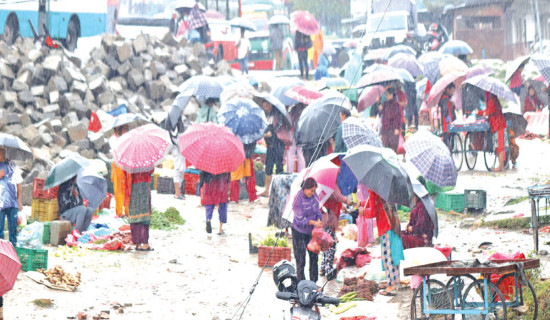- Tuesday, 9 December 2025
Drought, poor irrigation hit paddy plantation
Kathmandu, Aug. 3: Most farmers in Nepal heavily depend on monsoon rains to grow paddy and other crops due to limited
irrigation facilities.
Although an agrarian country and rich in water resources, Nepal has failed to develop irrigation infrastructure. It was evident this year when many farmers in Madhes and Koshi provinces are unable to plant paddy even at the end of the plantation season due to a lack of adequate rainfall.
Poor paddy plantation is sure to pose a challenge to the country's food security and national economy.
Agriculture experts and government officials said long drought and lack of rainfall have badly affected plantations nationwide.
Paddy cultivation in the Madhes Province has been affected this season by prolonged drought.
The delay and scarcity of rainfall, coupled with the lack of functional irrigation systems, have severely disrupted paddy plantation, said agricultural expert Dr. Devendra Gauchan.
“With rainfall below average and many irrigation canals either dry or poorly maintained, farmers are struggling to transplant paddy,” he said.
Madhes Province has reported the lowest paddy plantation progress among all seven provinces in the country as of July end this year.
According to statistics of the Ministry of Land Management, Agriculture, Cooperative of Madhes Province government, plantation has been completed only in 57 per cent of total paddy fields by August 1 due to the long spell of drought.
Out of 372,645 hectares of paddy fields in the province, plantation has been completed in only 213,438 hectares, significantly lagging behind the national average above 80 per cent.
Director General of the Department of Agriculture Dr. Prakash Kumar Sanjel attributed this decline in paddy plantation to lack of rainfall.
Compared to the same period last year, the plantation in Madhes Province has dropped by over 35 per cent, raising concerns among farmers, agricultural experts, and policymakers about potential impacts on food security and farmers' incomes
Last year, by end July, plantation had been completed in around 94 per cent of paddy fields.
“The inadequate and delayed monsoon rains have hit our farmers hard. Irrigation systems are limited, and many rely heavily on rainfall. Without timely provision of water, transplanting becomes nearly impossible,”
said Sanjel.
The plantation not only affected Madhes Province, but also other provinces except Lumbini this year.
The paddy plantation has been done around in 1,087,148 hectares (78.84 per cent) of the country’s total 1.38 million hectares of paddy fields by July 27.
The paddy plantation has been lower almost by 14 per cent by July 27 this year compared with the same time last year. The plantation was done in around 92.6 per cent of total paddy fields by
July 27, 2024.
Paddy has been planted in 99 per cent (174,286 hectares) of the total paddy fields in Sudurpashchim Province, 92.4 per cent (278,828 hectares) in Lumbini Province, and 91.38 per cent (37,505 hectares) in Karnali Province.
Likewise, 87.19 per cent (101,606 hectares) paddy plantation has been completed in Bagmati Province, 84.53 per cent (79,613 hectares) in Gandaki Province and 80.39 per cent (222,192 hectares) in Koshi Province.
Inadequate irrigation system
As the country is largely dependent on agriculture, Nepal’s inability to provide consistent irrigation is a major hurdle in its path to economic development.
Dr. Gauchan said that it is unfortunate that in a country with vast water resource potential, where nearly two-thirds of the population is engaged in agriculture, 70 per cent of the cultivable land still lacks irrigation facilities throughout the year.
According to the Department of Water Resources and Irrigation under the Ministry of Energy, Water Resources and Irrigation, only 35 per cent of Nepal’s total arable land has access to year-round irrigation.
This severely hampers productivity and makes farmers vulnerable to erratic weather and droughts, which are becoming more frequent due to climate change.
"Of the 3.56 million hectares of arable land, only 2.54 million hectares are considered suitable for irrigation. However, only 1.57 million hectares of that land currently have some form of irrigation access — only 35 per cent (550,000 hectares) of land has year-round irrigation systems," said Bashu Dev Timilsina, deputy director general at the Department of Water Resources and Irrigation.
See Page 6
Of the total 1.57 million hectares of land covered by irrigation infrastructure, around 81 per cent falls in the Tarai, 15 per cent in hills 4 per cent in mountains.
He said that irrigation facilities have been extended to about 62 per cent of total cultivable land.
“However, the majorities of systems are either run-of-the-river or based on natural springs, which have dried up this year. So, despite some coverage, they are not reliable throughout the year,” he said.
Surface irrigation currently serves 68 per cent (1,069,295 hectares) of cultivable land, while the remaining 32 per cent (498,268 hectares) is covered through underground sources.
However, the reliability and efficiency of many of these systems are under question due to lack of maintenance and depleting water sources.
Of total 580,000 hectares of arable land in Madhes Province, the command area covered by irrigation infrastructure is 383,000 hectares, including surface irrigation (209,000 hectares) and groundwater irrigation (173,000 hectares) system.
For sustainable irrigation facilities and high agricultural yield, the government has forwarded construction of various mega and national pride projects over the past few decades, Timilsina said.
History of developing irrigation facilities in Nepal goes back to 1922 when the construction of Chandra Nahar (canal) began during the time of Prime Minister Chandra Shumsher Rana. The canal construction completed in six years and water distribution began in 1928.
The development of modern irrigation facility began from the government in the early 1950s and since then, the government has been running small and large irrigation and river management projects at its own investment and in assistance of various national and international organisations, he said.
Various projects of national pride, such as Sikta Irrigation Project, Sunkoshi Marin Diversion Multipurpose Project, Mahakali Irrigation Project, Rani Jamara Kulariya Irrigation Project, Babai Irrigation Project and Bheri-Babai Diversion Multipurpose Project, are at various stages of construction.
Prime Minister KP Sharma recently inaugurated the Rani Jamara Kulariya Irrigation Project.
Likewise, Bagmati Irrigation Project (including Sunkoshi Marin Diversion) that will provide irrigation facilities to 122,000 hectares of land in Sarlahi, Rautahat, Bara, Dhanusha and Mahottari districts in Madhes and Mahakali Irrigation Project (Phase III) to irrigate 33,520 hectares of land in Kailali and Kanchanpur districts are also under construction.
Sunkoshi Kamala Irrigation Project which is under study will cover about 76,400 hectares.
Challenging for food security, country's GDP
Madhes Province, often known as Nepal’s bread basket, is currently grappling with an unprecedented drought. The region, which plays a crucial role in national paddy production, has been left parched due to lack of rainfall.
Fields are cracking in the absence of rainfall, and ready rice seedlings are withering and dying due to lack of water. Even the transplanted paddy seedlings are now dying due to drought.
The federal government has officially declared the region a drought-affected zone. Prime Minister KP Sharma Oli recently inspected the Madhes Province and committed to install 500 deep-boring in Madhes immediately to provide relief to drought-affected people of the province.
Dr. Gauchan said that if the drought continues for another two weeks in Madhes Province, it will not only affect planting, but it will also be difficult to save the planted rice.
He warned that this could lead to a substantial decline in paddy yield, further straining food security, local livelihoods and country's overall economic growth.
He predicted that the production of paddy is likely to decrease by around 20-25 per cent this year as plantation has dropped in all provinces
than last year.
“Paddy accounts for nearly 50 per cent of Nepal’s total cereal output. A fall in production in Madhes will affect the entire country’s food supply chain,” he warned. “If rain doesn’t arrive in the next couple of weeks, the situation will worsen further.”
Nepal's total paddy production last fiscal year was 5.72 million tonnes, with Koshi producing the highest quantity at 1.43 million tonnes, followed by Madhes (1.33 million tonnes) and Lumbini (1.31 million tonnes).
Share of Madhes Province in paddy production stands around 23 per cent.
DG Sanjel said that the present situation of drought in Madhes province is certain to affect the overall food production along with paddy as the Madhes Province shares over 20 per cent of total cereals production.
Of the total cereals production of 11.29 million tonnes, around 2.23 million tonnes is produced in Madhes Province, third highest among the provinces. Besides this, Madhes also produces lentils, pulses and other cash crops such as sugarcane and others.
Koshi Province has occupied first place in cereals production with 2.71 million tonnes while Lumbini Province occupied the second position with 2.35 million tonnes.
"The statistics shows that there is not only low plantation, it is equally challenging to preserve the planted paddy due to lack of rainfall. However, we expect that the plantation will improve and the planted rice will be saved," he said.
He, however, said that the drought in Madhes has made us more serious about building sustainable surface irrigation infrastructure in Madhes and other provinces as well.
"We need to take an integrated approach to sustain agriculture, such as irrigation, dry-tolerant seed to increase production and make the country safe in food security when drought arises," he said.
Stating that there are huge numbers of boring in the fields of Madhes, Dr. Gauchan said that due to the impact of climate change, the boring has also dried up.
He said that the import of rice and paddy will double this year. Rice and paddy worth Rs. 40 billion were imported in the last fiscal year.
"A reduction in rice production will not only affect imports, it will also have a multiplier effect on the overall economy. When rice production decreases, it will hit GDP and inflation as well,” he said.
Paddy alone contributes about 13 per cent to the agricultural GDP and 7 per cent to the overall national GDP.
Need for sustainable solutions
Experts and government officials are urging for urgent investments in modern and climate-resilient irrigation systems.
“We need to accelerate the development of surface irrigation systems and move away from unsustainable methods like shallow tube wells and diesel-run boring, which are failing due to groundwater depletion,” said Dr. Gauchan
He suggested climate-adaptive agriculture practices, such as drought-resistant crop varieties, efficient water management, and changes in cropping patterns.
The Tarai is known as a storehouse of foods, Sanjel said, adding that it is a must to ensure access to irrigation facilities in the entire fields to make the country self-reliant in food.
"Even though the boring and shallow tube well irrigation projects are being developed in the Tarai, it is costly, and it is not a sustainable means of irrigation. So, it is a must to expand the command area of irrigation through the surface water irrigation infrastructure," he said.
“The current crisis is a wake-up call. If we continue to rely on rain-fed agriculture, the dream of food self-sufficiency will remain out of reach,” said joint secretary Sanjel.
He, however, said that the government has been focusing on climate-friendly agricultural tools for increasing agricultural produce.



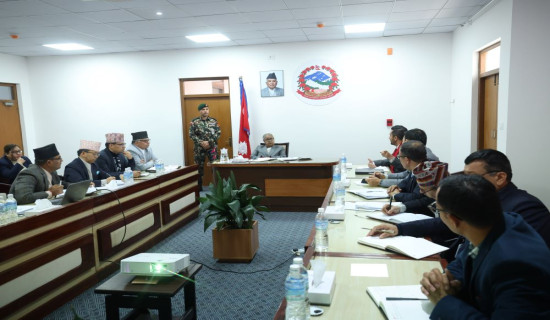
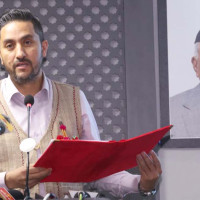
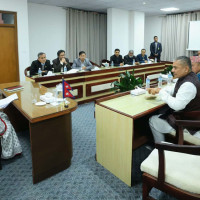

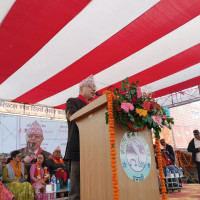



-original-thumb.jpg)


-original-thumb.jpg)

